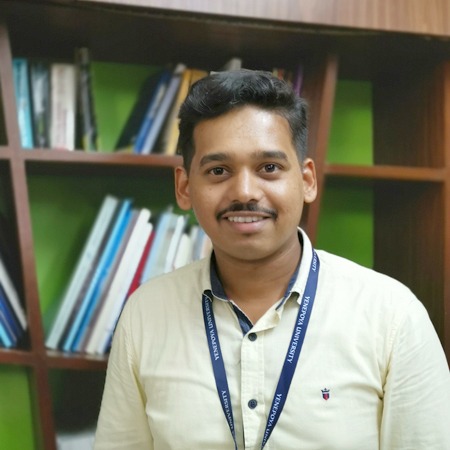

Dr. Rajesh P. Shastry
Assistant Professor
-
PhD, Microbiology
-
MSc-Microbiology
-
rpshastry@yenepoya.edu.in
I joined the Yenepoya Research centre in 2018. I received PhD from the University of Mysore, Mysore for Novel quorum quenching enzymes from endophytes. Afterwards I did my Postdoctoral training at Cambridge University, Cambridge, UK. My research interests are infectious diseases, including Gram negative infectious pathogens like Pseudomonas aeruginosa, Burkholderia cepacia, Salmonella species and E. coli, control of pathogenesis and host-pathogen interactions.
PostDoc/Experience
- Lecturer at DOS in Microbiology, University of Mysore, Mysore (2017)
- Visiting Scientist at Department of Biochemistry, University of Cambridge, Cambridge, UK (2016)
- Research fellow at DOS in Microbiology, University of Mysore, Mysore (2011)
- R&D Scientist at Medreich Limited, Bangalore (2009-2010)
Awards/Honors
- Cambridge-Hamied Visiting Fellowship (2018) funded by University of Cambridge, U.K.
- Newton Bhabha fellowship (2016) funded by DST, New Delhi and British Council, U.K.
- DST INSPIRE Fellowship (2011) funded by Department of Science and Technology, DST, New-Delhi
- First Rank with Gold Medal (2010) in M.Sc., Microbiology from Mangalore University, Mangaluru
- Vaidya Partha Narayana Pandit and Family cash prize (2010) awarded by Mangalore University, Mangalore
- Proficiency prize in B.Sc., Microbiology (2008) awarded by Mangalore University, Mangalore
Research Interest/Area: Keywords: Infectious diseases, Quorum sensing and quenching, Antimicrobial Resistance, Structural biology, Microbial enzymes, Microbiome
Research:
My research laboratory investigates role of quorum sensing in infectious diseases. Studies are directed towards understanding the role of QS in development of anti-microbial resistance (AMR). Our lab also studies on control of biofilm associated lung infections.
Microbiome and Quorum sensing
The precise role of quorum sensing and human gut microbiome in health and disease states remains poorly understood. The selectivity and complex crosstalk between microbiome and mammalian cells are not well characterized. Our lab focused on characterization of bacterial virulence as well as its establishment on mammalian cells with respect to its crosstalk intermediate metabolic activity and regulation pathways.
Glyoxylate shunt in Gram negative bacteria
Utilization of acetate and fatty acids as carbon source by gluconeogenesis under physiological conditions has essential step known as glyoxylate shunt (GS). The role of quorum sensing in glyoxylate cycle is poorly understood. Therefore, characterization of the enzymes of glyoxylate shunt and quorum sensing regulated genes could be a major non-traditional molecular drug target.
- Shastry, P., Dolan, S.K., Abdelhamid, Y., Vittal, R.R., and Welch, M. (2018). Purification and characterisation of a quorum quenching AHL-lactonase from the endophytic bacterium Enterobacter sp. CS66. FEMS Microbiol. Lett. 365.
- Rajesh, P.S., and Rai, V.R. (2015b). Use of aiiA gene amplification for AHL-lactonase production from endophytic bacterium Enterobacter sInt. J. Biol. Macromol. 72, 1013–1019.
- Rajesh, S., and Rai, V.R. (2015a). Purification and antibiofilm activity of AHL-lactonase from endophytic Enterobacter aerogenes VT66. Int. J. Biol. Macromol. 81, 1046–1052.
- Rajesh, S., and Rai, V.R. (2014b). Quorum quenching activity in cell-free lysate of endophytic bacteria isolated from Pterocarpus santalinusLinn., and its effect on quorum sensing regulated biofilm in Pseudomonas aeruginosa PAO1. Microbiol. Res. 169, 561–569.
- Rajesh, S., and Rai, V.R. (2014a). Molecular identification of aiiA homologous gene from endophytic Enterobacter species and in silico analysis of putative tertiary structure of AHL-lactonase. Biochem. Biophys. Res. Commun. 443, 290–295.
Books/Book Chapters
- Rai, V. R and Shastry, R.P (2015) Probiotics: Live Medicines in Human Gut. Edited Book Chapter, CRC Press. 447-459.
- Rajesh, P. Shastry and Rai, V. R. (2017) Quorum quenching endophytes: A novel approach for sustainable development of Agroecosystem Edited Book Chapter “Sustainable Development and Biodiversity” Springer Publication. 15, 41-57.
- Rajesh, P. S., and Rai, V. R. (2018) Market Potential of food nanotechnology innovations Edited Book Chapter, CRC Press. 59-72.
PI:
- DST-SYST grant: Designing and Fabrication of micro fluidic PDMS Paper chip for early detection of neonatal sepsis (Cost: 28.41 lakhs), Year: 2020-23.
- ICMR-DHR grant: Gut microbiome and cancer cells crosstalk as a molecular drug target for colon cancer (Cost: 30.52 lakhs), Year: 2021-24.
- Seed grant (Yenepoya University): Combination therapy strategy using antibiotics and AHL analogues for Pseudomonas aeruginosa infection in Caenorhabditis elegans model (Cost: 6 lakhs), Year: 2019-22.
- DBT grant: Therapeutic Potential of AHL Analogues through Neutrophil Extracellular Traps Mediated Bacterial Clearance during Chronic Obstructive Pulmonary Disease (44.055 lakhs), Year: 2021-24.
- Renjith P. Johnson, Rajesh P. Shastry, Namitha K. Preman and Nikitha A., “Anti-dermatophytic Hydrogel for Topical Applications” Indian patent, provisional specification, 2019, No-2019410477486.


